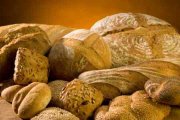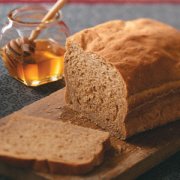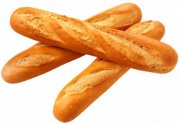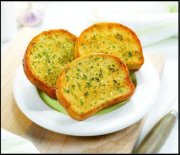Bread Nutrition Facts
Bread Nutrition Facts Calories, Carbohydrates and Health Benefits
 Bread, as we know is, is part of the carbohydrates group. This is together with foods such as potatoes, rice, cereal, pasta and the like. Most of these carbs are made from grain (excluding potatoes of course!). When it comes to grain, it can either be processed or unprocessed, leading to what are normally known as "refined" foods and "unrefined" foods. The latter have the whole grain still in tact whilst the opposite is true for refined foods. They would have had most of the nutrients removed, however, some manufacturers try to compensate by adding in nutrients themselves in the food, also known as the "enriched" foods.
Bread, as we know is, is part of the carbohydrates group. This is together with foods such as potatoes, rice, cereal, pasta and the like. Most of these carbs are made from grain (excluding potatoes of course!). When it comes to grain, it can either be processed or unprocessed, leading to what are normally known as "refined" foods and "unrefined" foods. The latter have the whole grain still in tact whilst the opposite is true for refined foods. They would have had most of the nutrients removed, however, some manufacturers try to compensate by adding in nutrients themselves in the food, also known as the "enriched" foods.
Whole grain foods are especially important when you are thinking of eating healthy. Not only will you gain carbohydrates, but some fiber, protein and a couple of other nutrients that your body needs. A few examples of refined foods include white bread, white rice and white pasta. A few examples of unrefined foods include popcorn, whole wheat bread, whole grain cereals such as oatmeal and muesli, brown rice and rye bread. Nutrition facts on bread reveal that it is a good source of iron, protein, vitamins, calcium and fiber for the whole grain/wheat varieties. Fiber in particular helps to keep your digestive system healthy.
Whole wheat breads, in most cases are better than white bread. It is especially true for those who want to lose weight and not just end there but maintain a healthy weight also. It is important to check the ingredients panel of the bread of your choice. If whole grain, whole wheat or stone ground is not the first or second ingredient, that may not be the healthiest bread choice for you. The salt and sugar content should also be low and the bread should not contain any preservatives.
Some of the whole wheat or whole grain breads' health benefits include; reduced inflammation (this means such breads can be included in the foods that fight pain list.), reduced risk of heart diseases, type 2 diabetes and decreaasing problems of the gastrointestinal tracts, amongst many other benefits. Bread is a common food that you find at breakfast tables or in the luchboxes making sandwiches. Some common favored types of breads include whole wheat, pumpkin, banana-nut, apple spice, carrot, sweet potato breads as well as the seed loaf.
We will now take a look at some bread nutrition facts. The percent daily values (DV) are based on a 2,000 calorie diet. Your values may be higher or lower depending on your daily calorie needs.
White Bread Nutrition Facts
These are nutrition facts for white bread that has been prepared commercially prepared. They also include soft bread crumbs. It is apparent that white bread is made from white flour that has been refined. This means it has had most of the valuable removed. However, some of the nutrients are added later on in the process of making the white bread. It therefore makes it a source of a number of minerals, nutrients and vitamins including Protein, Dietary Fiber, Calcium, Iron, Vitamin K, Thiamin amongst many others. Even though it has these nutrients, most individuals who are watching their weight try to avoid it by all means.

- Serving size- 1 slice (25g)
- Calories- 66
- Calories from Fat- 7
- Total Fat- 1g, 1% DV
- Saturated Fat- 0g
- Trans Fat- 0g
- Cholesterol- 10mg, 0% DV
- Sodium- 170mg, 7% DV
- Total Carbohydrate- 13g, 4% DV
- Dietary Fiber- 1g, 2% DV
- Sugars- 1g
- Protein- 2g, 4% DV
- Vitamin A- 0% DV
- Vitamin C- 0% DV
- Calcium- 4% DV
- Iron- 5% DV
- Vitamin K- 1% DV
- Thiamin- 8% DV
- Riboflavin- 5% DV
- Niacin- 5% DV
- Vitamin B6- 1% DV
- Folate- 7% DV
- Pantothenic Acid- 1% DV
- Magnesium- 1% DV
- Phosphorus- 2% DV
- Potassium- 1% DV
- Copper- 3% DV
- Manganese- 6% DV
- Selenium- 6% DV
Brown Bread Nutrition Facts
Most brown breads are made from whole wheat flour. The advantage of whole wheat flour is that it significantly boosts your intake of minerals, vitamins, fiber and other nutrients as compared to white bread. These are nutrition facts for J.J. Nissen Canadian brown bread. They show that it is a source of Dietary Fiber, Protein and Iron.

- Serving size- 1 slice (39g)
- Calories- 90
- Calories from Fat- 15
- Total Fat- 1.5g, 0% DV
- Saturated Fat- 0g
- Trans Fat- 0g
- Cholesterol- 170mg, 7% DV
- Sodium- 0mg
- Total Carbohydrate- 19g, 6% DV
- Dietary Fiber- 1g, 4% DV
- Sugars- 4g
- Protein- 3g, 6% DV
- Vitamin A- 0% DV
- Vitamin C- 0% DV
- Calcium- 0% DV
- Iron- 6% DV
Whole Grain Bread Nutrition Facts
It's important to understand the difference between multigrain and whole grain. Whole grain refers to the grain itself not being refined, being used in its whole state, i.e. the endosperm, gem and bran being left intact. Multigrain on the other hand means a particular food contains a number of grains (more than one grain).
In most cases, unless specified, it's not clear whether the grains used are whole or refined. These nutrition facts are for a multi-grain, toasted bread which has whole-grain. These multigrain whole grain bread nutrition facts reveal that it is especially a very good source of Manganese and Selenium. It is also a source of quite a couple of mineral, nutrients and vitamins.

- Serving size- 1 slice (24g)
- Calories- 69
- Calories From Fat- 10
- Total Fat- 1g, 2% DV
- Saturated Fat- 0g
- Trans Fat- 0g
- Cholesterol- 0mg
- Sodium- 110mg, 5% DV
- Total Carbohydrate- 11g, 4% DV
- Dietary Fiber- 2g, 8% DV
- Sugars- 2g
- Protein- 3g, 6% DV
- Vitamin A- 0% DV
- Vitamin C- 0% DV
- Calcium- 3% DV
- Iron- 4% DV
- Thiamin- 4% DV
- Riboflavin- 2% DV
- Niacin- 5% DV
- Vitamin B6- 3% DV
- Folate- 4% DV
- Pantothenic Acid- 1% DV
- Magnesium- 5% DV
- Phosphorus- 6% DV
- Potassium- 2% DV
- Zinc- 3% DV
- Copper- 4% DV
- Manganese- 26% DV
- Selenium- 12% DV
Rye Bread Nutrition Facts
Rye is one of the healthiest cereal grains there is. One of the causes for this is that it is difficult to seperate the rye grain. This means it cannot be refined like the wheat grain. Rye bread is a good source of fiber, Manganese and Selenium. One of the other advantages of rye bread is that it can keep you satiated for longer. This is especially helpful for those who may want to lose weight. Rye also lowers the risk of health issues such as gallstones, cardiovascular diseases and type 2 diabetes amongst others.
- Serving size- 1 slice (32g)
- Calories- 83
- Calories from Fat- 9
- Total Fat- 1g, 2% DV
- Saturated Fat- 0g
- Trans Fat- 0g
- Cholesterol- 0mg
- Sodium- 211mg, 9% DV
- Total Carbohydrate- 15g, 5% DV
- Dietary Fiber- 2g, 8% DV
- Sugars- 1g
- Protein- 3g, 6% DV
- Vitamin A- 0% DV
- Vitamin C- 0% DV
- Calcium- 2% DV
- Iron- 5% DV
- Vitamin E- 1% DV
- Thiamin- 9% DV
- Riboflavin- 6% DV
- Niacin- 6% DV
- Vitamin B6- 1% DV
- Pantothenic Acid- 1% DV
- Magnesium- 3% DV
- Phosphorus- 4% DV
- Potassium- 2% DV
- Zinc- 2% DV
- Copper- 3% DV
- Manganese- 13% DV
- Selenium- 14% DV
Bread Nutrition Facts: Baguette
This is Panera's french baguette. It is low in total fat and does not contain any saturated fat or cholesterol.It is also basically just a source of dietary fiber and a good source of carbohydrates.

- Serving size- 2 oz (57g)
- Calories- 180
- Calories from Fat- 0
- Total Fat- 1g, 1% DV
- Saturated Fat- 0g
- Trans Fat- 0g
- Cholesterol- 0mg
- Sodium- 440mg, 18% of DV
- Total Carbohydrate- 36g, 12% DV
- Dietary Fiber- 1g, 4% DV
- Sugars- 0g
- Protein- 6g, 12% DV
- Vitamin A- 0% DV
- Vitamin C- 0% DV
- Calcium- 0% DV
- Iron- 0% DV
Whole Wheat Bread Nutrition Facts
These are commercially prepared Whole wheat bread nutrition facts. Whole wheat is a preferred choice of bread by many as it is more nutritious than white bread. Also, for those who are diabetic whole wheat bread will work well as it will not cause your blood sugar levels to spike rapidly as much as white bread would. These nutrition facts show that it is a source of Protein, Calcium, Iron, Vitamin E, Vitamin K, Thiamin, Riboflavin, Vitamin B6, Folate, Magnesium and a few more. Whole wheat bread is also a very good source of Manganese and Selenium.

- Serving size- 1 slice (28g)
- Calories- 69
- Calories from Fat- 8
- Total Fat- 1g, 1% DV
- Saturated Fat- 0g
- Trans Fat- 0g
- Cholesterol- 0mg
- Sodium- 132mg
- Total Carbohydrate- 12g, 4% DV
- Dietary Fiber- 2g, 8% DV
- Sugars- 2g
- Protein- 4g, 8% DV
- Vitamin A- 0% DV
- Vitamin C- 0% DV
- Calcium- 3% DV
- Iron- 4% DV
- Vitamin E- 1% DV
- Vitamin K- 3% DV
- Thiamin- 7% DV
- Riboflavin- 4% DV
- Niacin- 7% DV
- Vitamin B6- 3% DV
- Folate- 3% DV
- Pantothenic Acid- 2% DV
- Magnesium- 6% DV
- Phosphorus- 6% DV
- Potassium- 2% DV
- Zinc- 3% DV
- Copper- 5% DV
- Manganese- 30% DV
- Selenium- 16% DV
Whole Wheat Pita Bread Nutrition Facts
Pita bread is common in many life circles including the Middle Eastern, Central African and Mediterranean circles. These whole wheat pita bread nutrition facts reveal that it is moderate in terms of its calories and cholesterol content. It is also low in total fat and sodium and does not contain any saturated fat.
Whole wheat pita bread, as expected, is a very good source of dietary fiber. It is also a good source of Protein, Carbohydrate, Iron, Thiamin, Magnesium and Phosphorus. In addition to this, whole wheat pita bread is an excellent source of Manganese and Selenium, as well as being a source of a couple of other minerals, vitamins and nutrients.

- Serving size- 1 large pita (64g)
- Calories- 170
- Calories from Fat- 14
- Total Fat- 2g, 3% DV
- Saturated Fat- 0g
- Trans Fat- 0g
- Cholesterol- 340mg, 14% DV
- Sodium- 104mg, 4% of DV
- Total Carbohydrate- 35g, 12% DV
- Dietary Fiber- 5g, 20% DV
- Sugars- 1g
- Protein- 6g, 12% DV
- Vitamin A- 0% DV
- Vitamin C- 0% DV
- Calcium- 1% DV
- Iron- 11% DV
- Vitamin E- 2% DV
- Vitamin K- 1% DV
- Thiamin- 14% DV
- Riboflavin- 3% DV
- Niacin- 9% DV
- Vitamin B6- 8% DV
- Folate- 6% DV
- Pantothenic Acid- 5% DV
- Magnesium- 11% DV
- Phosphorus- 12% DV
- Potassium- 3% DV
- Zinc- 6% DV
- Copper- 9% DV
- Manganese- 56% DV
- Selenium- 40% DV
White Enriched Pita Bread Nutrition Facts
When comparing whole wheat and white enriched pita bread nutrition facts, we realize that there are obviously some differences. White enriched pita bread contains slightly less calories, total fat, sodium, dietary fiber, protein, vitamin E and riboflavin than its whole wheat counterpart. It however has more Calcium, Thiamin and Folate. They are both sources of a number of nutrients, minerals and vitamins.
- Serving size- 1 large pita (60g)
- Calories- 165
- Calories from Fat- 6
- Total Fat- 1g, 1% DV
- Saturated Fat- 0g
- Trans Fat- 0g
- Cholesterol- 0mg
- Sodium- 322mg, 11% of DV
- Total Carbohydrate- 35g, 12% DV
- Dietary Fiber- 1g, 5% DV
- Sugars- 1g
- Protein- 5g, 10% DV
- Vitamin A- 0% DV
- Vitamin C- 0% DV
- Calcium- 5% DV
- Iron- 9% DV
- Vitamin E- 1% DV
- Thiamin- 24% DV
- Riboflavin- 12% DV
- Niacin- 14% DV
- Vitamin B6- 1% DV
- Folate- 16% DV
- Pantothenic Acid- 2% DV
- Magnesium- 4% DV
- Phosphorus- 6% DV
- Potassium- 2% DV
- Zinc- 3% DV
- Copper- 5% DV
- Manganese- 14% DV
- Selenium- 23% DV
Bread Nutrition Facts: Thins
These Oroweat whole wheat bread sandwich thins' nutrition facts show that they are a very good source of Folic Acid, Protein and Dietary Fiber. They are also an excellent source of calcium, providing you with 40% of your recommended daily value.

- Serving size- 1 bun
- Calories- 100
- Calories from Fat- 10
- Total Fat- 1g, 2% DV
- Saturated Fat- 0g
- Trans Fat- 0g
- Cholesterol- 0mg
- Sodium- 230mg, 10% of DV
- Potassium- 319mg- 9% DV
- Total Carbohydrate- 22g, 7% DV
- Dietary Fiber- 5g, 20% DV
- Sugars- 2g
- Protein- 5g, 10% DV
- Vitamin A- 0% DV
- Vitamin C- 0% DV
- Calcium- 40% DV
- Iron- 1% DV
- Niacin- 1% DV
- Folic Acid- 24% DV
Bread Nutrition Facts: Roll
These are plain dinner rolls that have been commercially prepared. The nutrition facts show that it is low in calories, saturated fat, total fat and sodium. It is basically a source of Protein, Calcium, Iron and Carbohydrates.

- Serving size- 1 roll (28g)
- Calories- 87
- Calories from Fat- 16
- Total Fat- 2g, 3% DV
- Saturated Fat- 0.4g, 2% DV
- Trans Fat- 0g
- Cholesterol- 1mg, 0% DV
- Sodium- 150mg, 6% of DV
- Total Carbohydrate- 15g, 5% DV
- Dietary Fiber- 1g, 2% DV
- Sugars- 1.6g
- Protein- 3g, 6% DV
- Vitamin A- 0% DV
- Vitamin C- 0% DV
- Calcium- 5% DV
- Iron- 6% DV
Bread Nutrition Facts: Pudding
Bread pudding is a great dessert. But do we know what comes along with it? In terms of calories, it is towards the high side, considering that this is just one cup. The total fat, sodium and saturated fat are moderate to high, but the cholesterol content is rather on the high side. This said, bread pudding is still a very good source of Calcium, Protein, Carbohydrates and Iron. But be on the look out for the sugar content.

- Serving size- 1 cup
- Calories- 306
- Calories From Fat- 85
- Total Fat- 10g, 16% DV
- Saturated Fat- 3g, 16% DV
- Trans Fat- 0g
- Cholesterol- 124mg, 41% DV
- Sodium- 472mg, 20% DV
- Total Carbohydrate- 47g, 16% DV
- Dietary Fiber- 2g, 8% DV
- Sugars- 29g
- Protein- 11g, 22% DV
- Vitamin A- 0% DV
- Vitamin C- 1% DV
- Calcium- 24% DV
- Iron- 13% DV
Bread Nutrition Facts: Flour
These are nutrition facts for white wheat bread flour that has been enriched. It's fairly high in terms of the caloric content. It however does not contain any fat, cholesterol and is low in it's sodium content. It is a good source of dietary fiber and an excellent source of the B-Vitamin Thiamin, Riboflavin, Niacin as well as Folate, Magnesium and Selenium.

- Serving size- 1 cup (137g)
- Calories- 495
- Calories from Fat- 19
- Total Fat- 2g, 3% DV
- Saturated Fat- 0g
- Trans Fat- 0g
- Cholesterol- 0mg
- Sodium- 3mg, 0% of DV
- Total Carbohydrate- 99g, 33% DV
- Dietary Fiber- 3g, 13% DV
- Sugars- 0g
- Protein- 16g, 32% DV
- Vitamin A- 0% DV
- Vitamin C- 0% DV
- Calcium- 2% DV
- Iron- 34% DV
- Vitamin E- 3% DV
- Vitamin K- 1% DV
- Thiamin- 74% DV
- Riboflavin- 41% DV
- Niacin- 52% DV
- Vitamin B6- 3% DV
- Folate- 63% DV
- Pantothenic Acid- 6% DV
- Magnesium- 9% DV
- Phosphorus- 13% DV
- Potassium- 4% DV
- Zinc- 8% DV
- Copper- 12% DV
- Manganese- 54% DV
- Selenium- 78% DV
Bread Nutrition Facts: Sticks
Soft bread stick nutrition facts reveal that it is basically a source of carbohydrates, dietary fiber, protein, calcium, iron and potassium. Which are all essential for our bodies.

- Serving size- 1 small stick
- Calories- 74
- Calories from Fat- 16
- Total Fat- 2g, 3% DV
- Saturated Fat- 0g
- Trans Fat- 0g
- Cholesterol- 0mg
- Sodium- 93mg, 4% of DV
- Total Carbohydrate- 12g, 4% DV
- Dietary Fiber- 1g, 4% DV
- Sugars- 0.22g
- Protein- 2g, 4% DV
- Vitamin A- 0% DV
- Vitamin C- 0% DV
- Calcium- 1% DV
- Iron- 4% DV
- Potassium- 1% DV
French or Vienna Bread Nutrition Facts
This french bread includes sourdough. These nutrition facts show that it is a good source of Selenium and Folate. It is also a source of a couple of other minerals, vitamins and nutrients.

- Serving size- 1 small slice (32g)
- Calories- 92
- Calories from Fat- 5
- Total Fat- 1g, 1% DV
- Saturated Fat- 0g
- Trans Fat- 0g
- Cholesterol- 0mg
- Sodium- 208mg, 9% of DV
- Total Carbohydrate- 18g, 6% DV
- Dietary Fiber- 1g, 4% DV
- Sugars- 1g
- Protein- 4g, 8% DV
- Vitamin A- 0% DV
- Vitamin C- 0% DV
- Calcium- 1% DV
- Iron- 6% DV
- Thiamin- 9% DV
- Riboflavin- 5% DV
- Niacin- 8% DV
- Vitamin B6- 2% DV
- Folate- 12% DV
- Pantothenic Acid- 1% DV
- Magnesium- 2% DV
- Phosphorus- 4% DV
- Potassium- 1% DV
- Zinc- 2% DV
- Copper- 2% DV
- Manganese- 8%
- Selenium- 12% DV
Garlic Bread Nutrition Facts
Garlic bread can be a favorite of many, especially if one loves garlic. And garlic is known to have healing properties and great health benefits for your body. The nutrition facts here show that it is a source of Iron, Protein, Dietary Fiber and Carbohydrates. It is moderate in terms of its sodium, total fat and saturated fat content. Garlic bread does not contain any cholesterol.

- Serving size- 1 slice (37g)
- Calories- 150
- Calories from Fat- 72
- Total Fat- 8g, 12% DV
- Saturated Fat- 2g, 8% DV
- Trans Fat- 0g
- Cholesterol- 0mg
- Sodium- 240mg, 10% of DV
- Total Carbohydrate- 16g, 5% DV
- Dietary Fiber- 1g, 4% DV
- Sugars- 1g
- Protein- 3g, 6% DV
- Vitamin A- 0% DV
- Vitamin C- 0% DV
- Calcium- 4% DV
- Iron- 8% DV
Panera, Ezekiel, Wonder Bread Nutrition Facts Comparison
These table includes panera, ezekiel and other types of bread nutrition facts comparison.
| Bread Type | Serving Size | Calories | Total Fat (g) | Saturated Fat (g) | Cholesterol (mg) | Sodium (mg) | Carbs (g) | Dietary Fiber (g) | Sugar (g) | Protein (g) |
| Panera's Whole Grain Loaf | 2 oz (57g) | 130 | 1 | 0 | 0 | 290 | 27 | 3 | 2 | 6 |
| Panera's Sesame Semolina Loaf | 2 oz (57g) | 140 | 0.5 | 0 | 0 | 360 | 28 | 1 | 0 | 5 |
| Panera's Stone-millet Rye Loaf | 2 oz (57g) | 140 | 0.5 | 0 | 0 | 380 | 28 | 2 | 0 | 5 |
| Panera's Ciabatta | 2 oz (57g) | 150 | 2 | 0 | 0 | 240 | 27 | 1 | 1 | 5 |
| Panera's 3 Cheese Loaf | 2 oz (57g) | 140 | 2 | 1 | 5 | 290 | 26 | 1 | 1 | 6 |
| Panera's Honey Wheat Loaf | 2 oz (57g) | 170 | 3 | 1.5 | 0 | 240 | 30 | 2 | 4 | 5 |
| Panera's Sourdough Round Loaf | 2 oz (57g) | 140 | 0.5 | 0 | 0 | 290 | 28 | 1 | 0 | 5 |
| Panera's Tomato Basil XL Loaf | 2 oz (57g) | 130 | 0.5 | 0 | 0 | 320 | 27 | 1 | 1 | 5 |
| Panera's White Whole Grain | 2 oz (57g) | 140 | 2.5 | 1 | 0 | 310 | 26 | 2 | 1 | 5 |
| Ezekiel 4:9 Organic Sprouted 100% Whole Grain Bread | 1.2 oz (34g) | 80 | 0.5 | 0.2 | 0 | 75 | 15 | 3 | 0 | 4 |
| Wonder Whole Grain Wheat Bread | 2 oz (57g) | 130 | 1.5 | 0 | 0 | 320 | 26 | 4 | 4 | 6 |
| Wonder Whole Grain Honey Wheat Bread | 2 oz (57g) | 140 | 2 | 0 | 0 | 330 | 26 | 2 | 4 | 6 |
| Wonder Stoneground 100% Whole Wheat | 2.4 oz (68g) | 180 | 2.5 | 0.5 | 0 | 400 | 32 | 4 | 5 | 7 |
| Wonder Light Wheat Bread | 1.6 (45g) | 80 | 0.5 | 0 | 0 | 240 | 18 | 5 | 4 | 5 |
Most of the bread types listed in this table are healthy options, one just needs to be on the look out for the amount of sodium and sugar.


